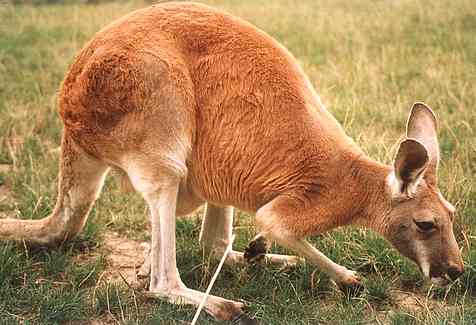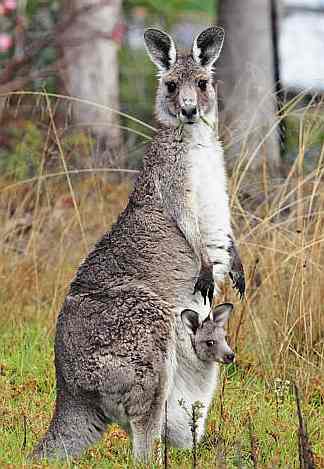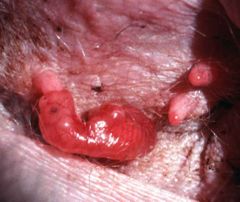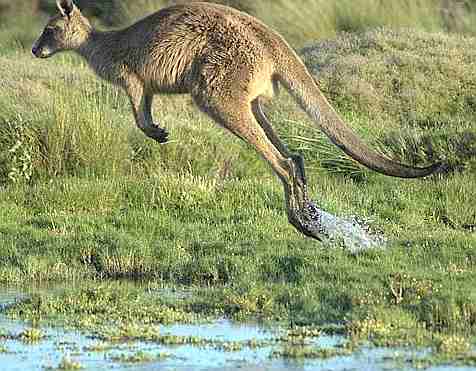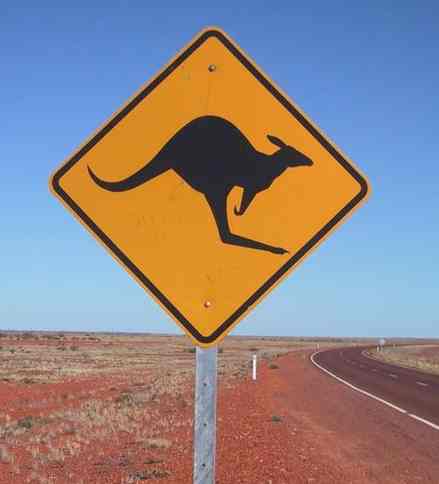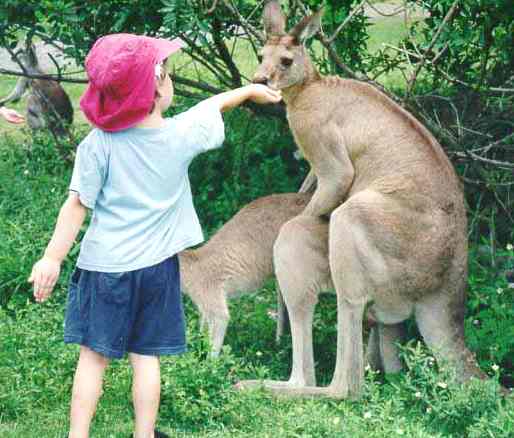|
KANGAROO
|
|||||||||||||||||||||||||||||||||||||||||||||||
|
HOME | BIOLOGY | BOOKS | FILMS | GEOGRAPHY | HISTORY | INDEX | INVESTORS | MUSIC | NEWS | SOLAR BOATS | SPORT |
|||||||||||||||||||||||||||||||||||||||||||||||
A kangaroo is a marsupial from the family Macropodidae. In common use the term is used to describe the largest species from this family, the Red Kangaroo, the Antilopine Kangaroo, and the Eastern and Western Grey Kangaroo of the Macropus genus. The family also includes many smaller species which include the wallabies, tree-kangaroos, wallaroos, pademelons and the Quokka, some 63 living species in all. Kangaroos are endemic to the continent of Australia, while the smaller macropods are found in Australia and New Guinea.
In general, larger kangaroos have adapted much better to changes wrought to the Australian landscape by humans, as many of their smaller cousins are endangered. However there is considerable controversy over farming of kangaroos for meat.
The kangaroo is an Australian icon: it is featured on the Australian Coat of Arms, on some currency, and is used by many Australian organizations, including Qantas.
Red Kangaroo (Macropus rufus)
Terminology
The word kangaroo derives from the Guugu Yimidhirr word gangurru, referring to a grey kangaroo. The name was first recorded as "Kangooroo or Kanguru" on 4 August 1770, by Lieutenant (later Captain) James Cook on the banks of the Endeavour River at the site of modern Cooktown, when HM Bark Endeavour was beached for almost seven weeks to repair damage sustained on the Great Barrier Reef.
A common legend about the kangaroo's English name is that it came from the Aboriginal words for "I don't understand you." According to this legend, Captain James Cook and naturalist Sir Joseph Banks were exploring Australia when they happened upon the animal. They asked a nearby local what the creatures were called. The local responded "Kangaroo", meaning "I don't understand you", which Cook took to be the name of the creature.
Kangaroo soon became adopted into standard English where it has come to mean any member of the family of kangaroos and wallabies. Male kangaroos are called bucks, boomers, jacks, or old men; females are does, flyers, or jills, and the young ones are joeys. The collective noun for kangaroos is a mob, troop, or court. Kangaroos are sometimes colloquially referred to as roos.
Overview
There are four species that are commonly referred to as kangaroos:
In addition, there are about 50 smaller macropods closely related to the kangaroo in the family Macropodidae.
Description
Kangaroos have long been regarded as strange animals. Early explorers described them as creatures that had heads like deer (without antlers), stood upright like men, and hopped like frogs. Combined with the two-headed appearance of a mother kangaroo, this led many back home to dismiss them as travellers tales for quite some time.
Kangaroos have large, powerful hind legs, large feet adapted for leaping, a long muscular tail for balance, and a small head. Like all marsupials, female kangaroos have a pouch called a marsupium in which joeys complete postnatal development.
Kangaroo and Joey in pouch
Behaviour
Headline text
Kangaroos are the only large animals to use hopping as a means of locomotion. The comfortable hoShakeemaBrownEyes@yahoo.com pping speed for Red Kangaroo is about 20–25 km/h (13–16 mph), but speeds of up to 70 km/h (44 mph) can be attained, over short distances, while it can sustain a speed of 40 km/h (25 mph) for more than a mile. This fast and energy-efficient method of travel has evolved because of the need to regularly cover large distances in search of food and water, rather than the need to escape predators.
Because of its long feet, it cannot walk normally. To move at slow speeds, it uses its tail to form a tripod with its two forelimbs. It then raises its hind feet forward, in a form of locomotion called "crawl-walking."
The average life expectancy of a kangaroo is about 4–6 years, with some living until they are about 23.
Diet
Kangaroos are large herbivores, feeding on grass and roots, and they chew cud. Many species are nocturnal and crepuscular, usually spending the days idling quietly and the cool evenings, nights and mornings moving about and feeding, typically in packs.
Because of its grazing, the kangaroo has developed specialized teeth. Its incisors are able to crop grass close to the ground, and its molars chop and grind the grass. Since the two sides of the lower jaw are not joined together, the lower incisors are farther apart, giving the kangaroo a wider bite. The silica in grass is abrasive, so kangaroo molars move forward as they are ground down, and eventually fall out, replaced by new teeth that grow in the back.
Different kangaroos also prefer different diets. The Red Kangaroo prefers dry grasses to juicy plants, because juicy grasses are very bulky, and the water inside takes too much space. The two gray kangaroo species, however, prefer soft, fresher grasses, as it is a woodland animal, opposed to the desert environment of the Red Kangaroo.
In dry weather, all kangaroos hold food in their digestive system for a longer period of time to absorb the last bits of moisture. However, gray kangaroos are more prone to dehydration, because they do not have much need to conserve water in their woodland habitat.
Kangaroo mum
Flatulence
Despite having a very similar diet to cows, kangaroos produce virtually no methane from digestion. The hydrogen byproduct of fermentation is instead converted into acetate, which is then used to provide further energy. Scientists are interested in the posibility of transfering the bacteria responsible from kangaroos to cattle, as methane is a greenhouse gas 23 times more powerful than carbon dioxide. [1]
Predators
Kangaroos have few natural predators. The Thylacine, considered by palaeontologists to have once been a major natural predator of the kangaroo, is now extinct. Other extinct predators included the Marsupial Lion, Megalania and the Wonambi. However, with the arrival of humans in Australia at least 50,000 years ago and the introduction of the dingo about 5,000 years ago, kangaroos have had to adapt. The mere barking of a dog can set a full-grown male boomer into a wild frenzy. Wedge-tailed Eagles and other raptors usually eat kangaroo carrion. Goannas and other carnivorous reptiles also pose a danger to smaller kangaroo species when other food sources are lacking.
Along with dingoes and other canids, introduced species like foxes and feral cats also pose a threat to kangaroo populations. Kangaroos and wallabies are adept swimmers, and often flee into waterways if presented with the option. If pursued into the water, a large kangaroo may use its forepaws to hold the predator underwater so as to drown it. Another defensive tactic described by witnesses is catching the attacking dog with the forepaws and disembowelling it with the hind legs.
Newborn joey sucking on a teat in the pouch
Adaptations
Kangaroos have developed a number of adaptations to a dry, infertile continent and highly variable climate. As with all marsupials, the young are born at a very early stage of development – after a gestation of 31–36 days. At this stage, only the forelimbs are somewhat developed, to allow the newborn to climb to the pouch and attach to a teat. In comparison, a human embryo at a similar stage of development would be about seven weeks old, and premature babies born at less than 23 weeks are usually not mature enough to survive. The joey will usually stay in the pouch for about nine months (180–320 days for the Western Grey) before starting to leave the pouch for small periods of time. It is usually fed by its mother until reaching 18 months.
The female kangaroo is usually pregnant in permanence, except on the day she gives birth; however, she has the ability to freeze the development of an embryo until the previous joey is able to leave the pouch. This is known as diapause, and will occur in times of drought and in areas with poor food sources. The composition of the milk produced by the mother varies according to the needs of the joey. In addition, the mother is able to produce two different kinds of milk simultaneously for the newborn and the older joey still in the pouch.
Unusually, during a dry period, males will not produce sperm, and females will only conceive if there has been enough rain to produce a large quantity of green vegetation.
Kangaroos and wallabies have large, stretchy tendons in their hind legs. They store elastic strain energy in the tendons of their large hind legs, providing most of the energy required for each hop by the spring action of the tendons rather than by any muscular effort. This is true in all animal species which have muscles connected to their skeleton through elastic elements such as tendons, but the effect is more pronounced in kangaroos.
There is also a link between the hopping action and breathing: as the feet leave the ground, air is expelled from the lungs; bringing the feet forward ready for landing refills the lungs, providing further energy efficiency. Studies of kangaroos and wallabies have demonstrated that, beyond the minimum energy expenditure required to hop at all, increased speed requires very little extra effort (much less than the same speed increase in, say, a horse, dog or human), and that the extra energy is required to carry extra weight. For kangaroos, the key benefit of hopping is not speed to escape predators—the top speed of a kangaroo is no higher than that of a similarly-sized quadruped, and the Australian native predators are in any case less fearsome than those of other continents—but economy: in an infertile continent with highly variable weather patterns, the ability of a kangaroo to travel long distances at moderately high speed in search of food sources is crucial to survival.
A sequencing project of the Kangaroo genome was started in 2004 as a collaboration between Australia (mainly funded by the state of Victoria) and the National Institutes of Health in the US. The genome of a marsupial such as the kangaroo is of great interest to scientists studying comparative genomics because marsupials are at an ideal degree of evolutionary divergence from humans: mice are too close and haven't developed many different functions, while birds are genetically too remote. The dairy industry has also expressed some interest in this project.
Kangaroo in mid jump Tasmanian Forester (Eastern Grey)
Kangaroo blindness
Eye disease is rare but not new among kangaroos. The first official report of kangaroo blindness took place in 1994, in central New South Wales. The following year, reports of blind kangaroos appeared in Victoria and South Australia. By 1996, the disease had spread "across the desert to western Australia". Australian authorities were concerned that the disease could spread to other livestock and possibly humans. Researchers at the Australian Animal Health Laboratories in Geelong detected a virus called the Wallal virus in two species of midge, believed to have been the carriers. Veterinarians also discovered that less than three percent of kangaroos exposed to the virus developed blindness.
Interaction with humans
Before European settlement, the kangaroo was a very important animal for Australian Aborigines, for its meat, hide, bones and sinews. In addition, there were important Dreaming stories and ceremonies involving the kangaroo. Aherrenge is a current kangaroo dreaming site in the Northern Territory. The game of Marn grook was played using a ball made from kangaroo by the Kurnai people.
Unlike many of the smaller macropods, kangaroos have fared well since European settlement. European settlers cut down forests to create vast grasslands for sheep and cattle grazing, added stock watering points in arid areas, and have substantially reduced the number of dingoes.
Kangaroos are shy and retiring by nature, and in normal circumstances present no threat to humans. Male kangaroos often "box" amongst each other, playfully, for dominance, or in competition for mates. The dexterity of their forepaws is utilised in both punching and grappling with the foe, but the real danger lies in a serious kick with the hindleg. The sharpened toenails can disembowel an opponent.
There are very few records of kangaroos attacking humans without provocation, however several such unprovoked attacks in 2004 spurred fears of a rabies-like disease possibly affecting the marsupials. The only reliably documented case of a fatality from a kangaroo attack occurred in New South Wales, in 1936. A hunter was killed when he tried to rescue his two dogs from a heated fray. Other suggested causes for erratic and dangerous kangaroo behaviour include extreme thirst and hunger.
In 2004, Lulu, an Eastern Grey, saved a farmer's life. She received the RSPCA National Animal Valor Award on May 19 of that year.
A "kangaroo crossing" sign on an Australian highway
Conflict with vehicles
A collision with a vehicle is capable of killing a kangaroo. Kangaroos blinded by headlights or startled by engine noise have been known to leap in front of cars. Since kangaroos in mid-bound can reach speeds of around 50 km/h (31 mph) and are relatively heavy, the force of impact can be severe. Small vehicles may be destroyed, while larger vehicles may suffer engine damage. The risk of harm to vehicle occupants is greatly increased if the windscreen is the point of impact. As a result, "kangaroo crossing" signs are commonplace in Australia.
Vehicles that frequent isolated roads, where roadside assistance may be scarce, are often fitted with "roo bars" to minimise damage caused by collision. Bonnet-mounted devices, designed to scare wildlife off the road with ultrasound and other methods, have been devised and marketed.
If a female is the victim of a collision, animal welfare groups ask that her pouch be checked for any surviving joey, in which case it may be removed to a wildlife sanctuary or veterinary surgeon for rehabilitation. Likewise, when an adult kangaroo is injured in a collision, a vet, the RSPCA or the National Parks and Wildlife Service can be consulted for instructions on proper care. In New South Wales, rehabilitation of kangaroos is carried out by volunteers from WIRES.
Kangaroo v Dingo
Hand-raising
Occasionally, individuals take on the task of rearing a recovered joey themselves. The rule-of-thumb says that if the joey is already covered with fur at the time of the accident (as opposed to still being in its embryonic stage), it stands a good chance of growing up properly. Lactose-free milk is required, otherwise the animal may develop blindness. They hop readily into a cloth bag when it is lowered in front of them approximately to the height where the mother's pouch would be. The joey's instinct is to "cuddle up", thereby endearing themselves to their keepers, but after hand-rearing a joey, it cannot usually be released into the wild and be expected to provide for itself immediately. Usually wildlife sanctuaries are willing to adopt kangaroos which are no longer practical, or have grown too large to contain, needing at least 1 acre and 7ft boundary fences for a fully grown kangaroo.
LINKS and REFERENCE
Kangaroo interrupted by child during courtship
LINKS and REFERENCES
MARSUPIALS:
Please use the Index below to navigate the Animal Kingdom:-
A taste for adventure capitalists
Solar Cola - a healthier alternative
|
|||||||||||||||||||||||||||||||||||||||||||||||
|
This
website
is Copyright © 1999 & 2012 NJK.
The bird |
|||||||||||||||||||||||||||||||||||||||||||||||
|
AUTOMOTIVE | BLUEBIRD | ELECTRIC CARS | ELECTRIC CYCLES | SOLAR CARS |
